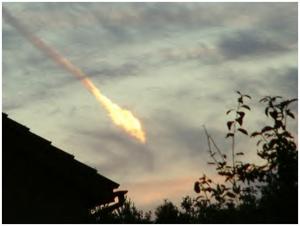Planetary securityPanel calls for global asteroid defense agency
Existing surveys are incapable of finding 90 percent of near-Earth asteroids that are 140 meters across or larger by 2020 — a goal set by the U.S. Congress in 2005; a panel of scientists recommends setting up an international body that would be prepared to spring into action and defend the planet if an asteroid is discovered on a likely impact course

Meteorite approaching Earth // Source: greatdreams.com
The world should organize its defenses now in case an asteroid is found on a collision course with Earth, says a group of U.S. scientists. There are huge numbers of asteroids that come close to Earth’s orbit, called near-Earth asteroids (NEAs). Millions of them are large enough to do serious damage in an impact, including the asteroid Apophis, which has a small chance of hitting Earth in 2036.
David Shiga writes that last Friday, a U.S. National Research Council panel led by Irwin Shapiro of the Harvard-Smithsonian Center for Astrophysics in Cambridge, Massachusetts, issued a report on how best to respond to the asteroid threat. It recommended setting up an international body that would be prepared to spring into action and defend the planet if an asteroid is discovered on a likely impact course. The international body would be “composed of representatives of nations concerned with this problem and willing to invest in preparedness for a damaging collision”, the report says.
If a dangerous asteroid were discovered far enough in advance, the group could organize a space mission to deflect it. “It’s the only natural disaster we know about where we could actually prevent it,” says Shapiro.
The report also found:
- Existing surveys are incapable of finding 90 percent of near-Earth asteroids that are 140 meters across or larger by 2020, a goal set by the U.S. Congress in 2005
- Launching a powerful asteroid-hunting space telescope could allow the goal to be met as early as 2022, but would likely cost more than $1 billion
- Radar observations by the giant Arecibo telescope in Puerto Rico allow NEA trajectories — and impact probabilities — to be determined most precisely, but uncertain funding threatens this capability. The report argues that the telescope’s radar-imaging capabilities be funded at $2.5 million per year
- The United States should initiate a research program to develop deflection technologies and to better understand impact effects like tsunamis
Shapiro says policymakers have not yet responded to the report, which was requested by the U.S. Congress in 2008. The panel issued an interim report in 2009 warning that small yet still dangerous asteroids are going undetected.
Congress has also called on the U.S. Office of Science and Technology Policy to recommend by October 2010 which agency or department, such as NASA or the Department of Defense, should lead US efforts to track dangerous asteroids and develop deflection technologies.
